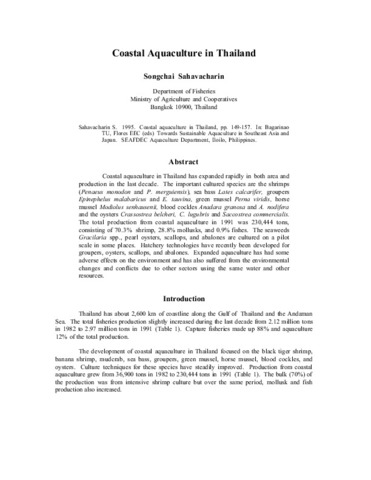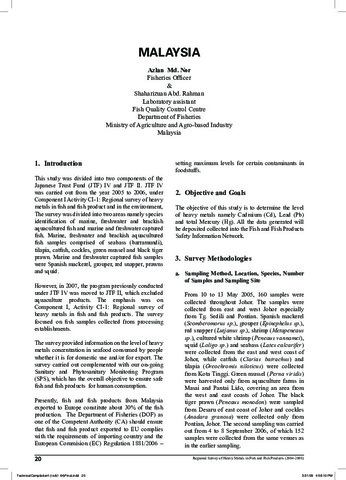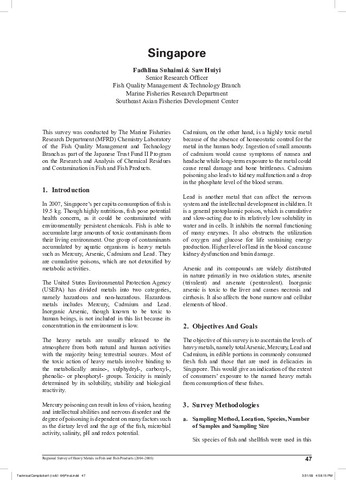| dc.contributor.author | Ng, Cher Siang | |
| dc.contributor.author | Low, Lai Kim | |
| dc.contributor.author | Chia, Lawrence H. L. | |
| dc.date.accessioned | 2023-02-28T08:42:09Z | |
| dc.date.available | 2023-02-28T08:42:09Z | |
| dc.date.issued | 1987 | |
| dc.identifier.citation | Ng, C. S., Low, L. K., & Chia, L. H. L. (1987). Preliminary investigations on a new method of retaining the colour of shucked cockles (Anadara Granosa), and the extension of shelflife by gamma irradiation and vacuum packing. International Journal of Radiation Applications and Instrumentation. Part C. Radiation Physics and Chemistry, 29(5), 325–335. https://doi.org/10.1016/1359-0197(87)90002-6 | en |
| dc.identifier.issn | 1359-0197 | |
| dc.identifier.uri | http://hdl.handle.net/20.500.12066/7183 | |
| dc.description.abstract | Live cockles were incubated in atmospheres containing different concentrations of carbon monoxide. Since CO combines more readily with myoglobin and haemoglobin than oxygen, the formation of in vivo deoxygenated haemoglobins and post mortem formation of methaemoglobin were retarded by the more stable carboxyhaemoglobin (HbCO). The bright red colour of the stable HbCO is retained during storage, giving the desired colour to the cockles. The colour of normal, chilled cockle meat deteriorated after 3 days ice storage while those treated with 50 and 100% CO retained the bright deep orange colour up to 10 days storage. Irradiation caused faster colour deterioration in both CO and non-CO treated samples. Vacuum packing influenced the colour of the cockles with irradiation and with CO treatments. In non-CO treated, irradiated samples, the effect of vacuum packing was not obvious. In CO treated, irradiated samples, vacuum packing retarded the deterioration of colour.
Odour developments were influenced by irradiation, vacuum packing and storage temperature, and were not influenced by CO treatments. Irradiation suppressed the development of odour for the first 11 days storage (0°C) while vacuum packing depressed the odour by lowering its intensity instead. Odour development was slowed down by lowering the storage temperature. The odour of shucked cockles was rejected within one day at room temperature (26–28°C) while at 0°C the odour of the shucked cockles was still acceptable after 10 days.
Suitable chemical indices for quality are K value and TVBN. Treatment with CO did not influence the K value development. Vacuum packing produced the highest K values after 19 days storage (0°C), while irradiated samples had higher K values than non-irradiated samples. The TVBN increased with storage and is an indicator of the odour development.
The use of CO treatment extended the shelflife of the cockles based on appearance. A combination of CO treatment, vacuum packing, ice storage and irradiation extended the shelflife to beyond 18 days, based on odour, colour, and overall appearance. | en |
| dc.language.iso | en | en |
| dc.publisher | Elsevier | en |
| dc.subject | Anadara granosa | en |
| dc.subject | vacuum packaging | en |
| dc.subject | gamma irradiation | en |
| dc.title | Preliminary investigations on a new method of retaining the colour of shucked cockles (Anadara Granosa), and the extension of shelflife by gamma irradiation and vacuum packing | en |
| dc.type | Article | en |
| dc.citation.volume | 29 | en |
| dc.citation.issue | 5 | en |
| dc.citation.spage | 325 | en |
| dc.citation.epage | 335 | en |
| dc.citation.journalTitle | International Journal of Radiation Applications and Instrumentation. Part C. Radiation Physics and Chemistry | en |
| dc.subject.asfa | colour | en |
| dc.subject.asfa | clam fisheries | en |
| dc.identifier.doi | 10.1016/1359-0197(87)90002-6 | |
| dc.subject.scientificName | Anadara granosa | en |
| dc.subject.scientificName | Tegillarca granosa | en |



